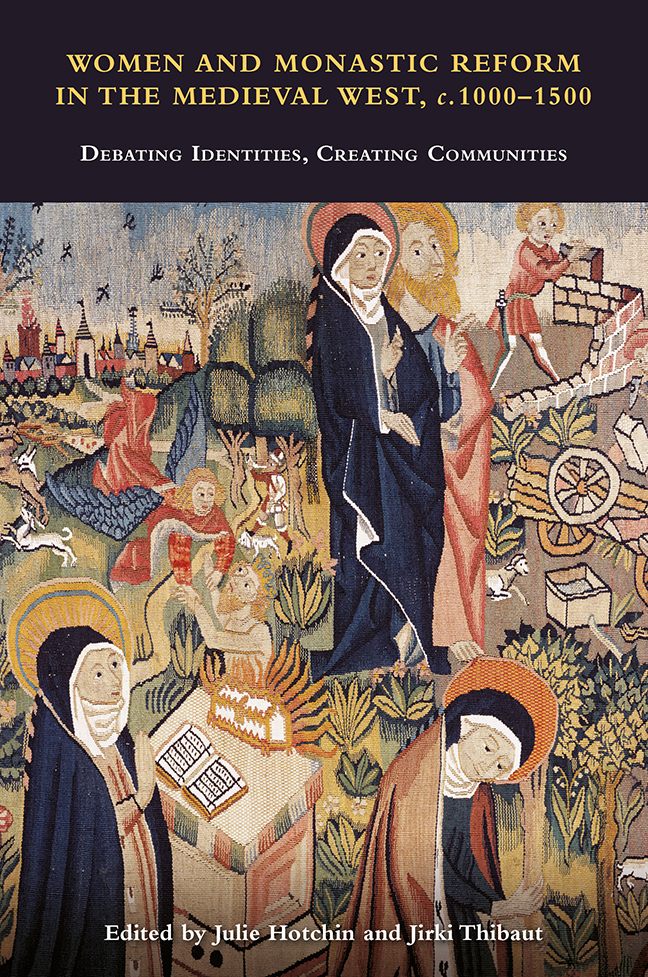 Women and Monastic Reform in the Medieval West, c.100-1500
Women and Monastic Reform in the Medieval West, c.100-1500 Book contents
- Frontmatter
- Dedication
- Contents
- List of Illustrations
- List of Contributors
- Acknowledgements
- List of Abbreviations
- 1 Debating Identities: Women and Monastic Reform in the Medieval West, c. 1000–1500
- 2 Liturgy and Female Monastic Hagiography Around the Year 1000: A lecture croisée of the Life of Liutrud, the Second Life of Glodesind of Metz and the So-called Pontificale Romano-Germanicum
- 3 Remakers of Reform: The Women Religious of Leominster and their Prayerbook
- 4 The Materiality of Female Religious Reform in Twelfth-Century Ireland: The Case of Co-located Religious Houses
- 5 Women as Witnesses: Picturing Gender and Spiritual Identity in a Twelfth-Century Embroidered Fragment from Northern Germany
- 6 Mulieres religiose and Cistercian Nuns in Northern Italy in the Thirteenth Century: A Choice of ‘Order’
- 7 Circulation of Books and Reform Ideas between Female Monasteries in Medieval Castile: From Twelfth-Century Cistercians to the Observant Reform
- 8 Women, Men and Local Monasticism in Late Medieval Bologna
- 9 Building Community: Material Concerns in the Fifteenth-Century Monastic Reform
- 10 Who Made Reform Visible? Male and Female Agency in Changing Visual Culture
- 11 Nuns, Cistercian Chant and Observant Reform in the Southern Low Countries
- Index
- Other volumes in Studies in the History of Medieval Religion
2 - Liturgy and Female Monastic Hagiography Around the Year 1000: A lecture croisée of the Life of Liutrud, the Second Life of Glodesind of Metz and the So-called Pontificale Romano-Germanicum
Published online by Cambridge University Press: 09 January 2024
- Frontmatter
- Dedication
- Contents
- List of Illustrations
- List of Contributors
- Acknowledgements
- List of Abbreviations
- 1 Debating Identities: Women and Monastic Reform in the Medieval West, c. 1000–1500
- 2 Liturgy and Female Monastic Hagiography Around the Year 1000: A lecture croisée of the Life of Liutrud, the Second Life of Glodesind of Metz and the So-called Pontificale Romano-Germanicum
- 3 Remakers of Reform: The Women Religious of Leominster and their Prayerbook
- 4 The Materiality of Female Religious Reform in Twelfth-Century Ireland: The Case of Co-located Religious Houses
- 5 Women as Witnesses: Picturing Gender and Spiritual Identity in a Twelfth-Century Embroidered Fragment from Northern Germany
- 6 Mulieres religiose and Cistercian Nuns in Northern Italy in the Thirteenth Century: A Choice of ‘Order’
- 7 Circulation of Books and Reform Ideas between Female Monasteries in Medieval Castile: From Twelfth-Century Cistercians to the Observant Reform
- 8 Women, Men and Local Monasticism in Late Medieval Bologna
- 9 Building Community: Material Concerns in the Fifteenth-Century Monastic Reform
- 10 Who Made Reform Visible? Male and Female Agency in Changing Visual Culture
- 11 Nuns, Cistercian Chant and Observant Reform in the Southern Low Countries
- Index
- Other volumes in Studies in the History of Medieval Religion
Summary
In a fundamental essay published in 1991 on the significance of religious women’s communities in early and high medieval Saxony, the late Michel Parisse called for a comparative perspective on the political, social and religious conditions of the conspicuous density of women's communities in Saxony. In doing so, he referred to his home region of Lorraine, for which he – amongst others – used the term Lotharingia to describe its early medieval reality. In terms of sheer numbers, Lotharingia is indeed closest to the Saxon situation, but chronologically its monasteries also refer back to earlier times. Examples of this are the Merovingian foundations of Remiremont in the Vosges and Sainte-Glossinde and Saint-Pierreaux- Nonnains in the Carolingian lieu de mémoire Metz. Women's monasteries like these combined stabilising power in the Carolingian core lands with supra-regional influence within the framework of the Frankish regnum and imperium. For areas such as Saxony, which were integrated comparatively late into the Frankish sphere of influence, the politico-religious structures of the ancient parts of the Frankish realm provided a framework of tradition and reference far into the post-Carolingian period.
In this contribution – not least as an expression of gratitude to one of my academic teachers – I would like to take up Parisse's observations. I do not aim at a similarly broad investigation, especially since a comparative approach in a broad thematic perspective would go beyond the scope of the contribution as well as of this volume, even though recent studies on women's religious communities in Saxony and Lorraine invite us to do so. The focus is rather on a partial aspect: the textual and ideological relations between liturgy and hagiography in the tenth and early eleventh centuries. Such an approach is complementary to studies in which the importance of relics and hagiographical texts as vectors of communication, the transfer of ideas and the spatial integration of new secular and ecclesiastical structures of power were elaborated – again primarily for the Carolingian period. Following on from these studies, the observations in this article concentrate on religious and monastic aspects of these genres and raise questions about the shared significance of liturgy and hagiography for the definition and mediation of traditional as well as new ascetic and monastic models of life in the tenth century.
The debates which shaped these models are part of monastic and broader religious transformations traditionally labelled as the reform of the tenth and early eleventh century.
- Type
- Chapter
- Information
- Women and Monastic Reform in the Medieval West, c.100-1500Debating Identities, Creating Communities, pp. 24 - 56Publisher: Boydell & BrewerPrint publication year: 2023


